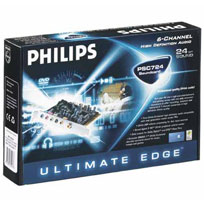Philips PSC724 Ultimate Edge
Introduction
The recent trend of PC integration into the user's living space finds the once small and dingy computer room becoming a thing of the past. With manufactures now offering PC solutions which showcase features that rival many mainstream audio components, families are now finding their "digital living room" to be the new media back-bone of their lives.
This is where Philips new soundcard, the PSC724 Ultimate Edge, steps in. Offering discreet 24-bit, 6-Channel High Definition Audio playback/recording, users can turn their PC into a high-end audio center with a simple upgrade. In addition to promising high end specs, Philips has integrated their newly redesigned Sound Agent 2 GUI to bring together all the features of the card into one highly configurable, easy to use interface.
Features and specifications aside, we here at HotHardware were looking forward to examining Philips' latest and greatest PC Audio product. A good majority of us here at HotHardware are audiophiles and this is our first look at a Philips product, so it should be an interesting showcase.
|
|
24-Bit 6-Channel PCI Audio Accelerator |
PSC724 |
|
|
Technical Specifications |
Product Highlights |
|
| Input/Output •Full duplex •Maximum Recording Depth: 24 bit •Maximum Recording Rate: 96 kHz •Maximum Playback Depth: 24 bit •Maximum Playback Rate: 192 kHz •Amplified 2.0 V RMS output Audio Quality (All Channels) •Frequency Response: 10Hz to 24kHz, <+/- 0.15dB •Signal to Noise Ratio: 106 dB, A-weighted (Typical) •Total Harmonic Distortion: 0.004% (Typical) Quality Connectivity Features (All 24-bit/96kHz resolution) •Front line out •Rear line out •Center/LFE line out •S/PDIF coaxial digital out •Microphone in •Auxiliary in •CD/video in •Line in Minimum System Requirements •One available PCI 2.2-compliant slot •Pentium III class 450 MHz or faster processor •Intel or 100% compatible motherboard chipset •64 MB system RAM •CD-ROM for driver installation •800x600 minimum screen resolution •35 MB free hard drive space |
Operating Systems Supported •Microsoft(R) Windows 2000 •Microsoft Windows XP Standards Compatibility •General MIDI compatible •Plug & Play •PCI 2.2 compliant •EAX(R) 1.0/2.0 game compatibility •Microsoft DirectSound(R), DirectSound 3D and derivatives Digital Signal Processor Algorithms •QSound3DInteractive™ positional 3D for 2-, 4-, or 6-channel speakers •QSound Multi Speaker System™ (QMSS5.1) for 4- or 6-channel output of stereo music files, multimedia and games •QSound Environmental Modeling for EAX™ and DirectSound3D™ games •QXpander™ for 3D enhancement of stereo playback •QSurround™ virtual 6-channel playback of multi-channel DVDs using stereo speakers
|
Pro-grade 24-bit hardware converters True 24-bit audio controller and codecs for bit-per-bit accurate High Definition audio quality providing 106 dB SNR. High Definition DSP Audio Engine Full 32-bit floating point digital signal processing with advanced audio effects and sonic enhancements. Intelligent Media Processing™ Automatically optimizes every sound stream based on format, speaker configuration and user preferences. Sound Agent 2 HD™ control center Award-winning and ultra-modern graphical user interface. 24-bit signal processing for ALL sources DSP effects and discrete stereo to multichannel conversion for all external media sources, e.g.,TV tuners, MP3 players—ANY input automatically upgraded to HD quality!
|
|
|
Click Image for Larger View |
The Philips PSC724 ships with your standard retail package. Included with the card itself, we found one driver CD, a quick installation guide, the warranty booklet and some literature about other Philips products. Missing from the bundle is the standard CD Audio connector and a SPDIF Coax patch cable. Though these are not necessary components that are required to connect the soundcard to your system, users who wish to take advantage of the digital interface may be disappointed to find that they need to purchase supplementary cabling.
|
Click Image for Larger View |
Looking at the card from a general construct point of view, we where pleased with the overall build quality. In reference to the pictures above, one can clearly see the five 1/8" mini-jack connectors in their standard color scheme; Line-In, Mic-In, Front Out, Rear Out and Center/LFE. The only abnormality, when compared to others, on the soundcard is the replacement of the once popular gameport with the SPDIF Out connector. In some cases, manufacturers will include the gameport on an additional extension bracket. However, in the case of the PSC724, Philips has done away with it all together under the assumption that most user are now using USB interfaced gaming peripherals.















